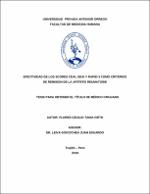Mostrar el registro sencillo del ítem
Efectividad de los scores CDAI, SDAI Y RAPID-3 como criterios de remisión de la artritis reumatoide
| dc.contributor.advisor | Leiva Goicochea, Juan Eduardo | |
| dc.contributor.author | Flores Cecilio, Tania Iveth | |
| dc.creator | Flores Cecilio, Tania Iveth | |
| dc.date.accessioned | 2019-07-23T16:35:27Z | |
| dc.date.available | 2019-07-23T16:35:27Z | |
| dc.date.issued | 2019 | |
| dc.identifier.uri | https://hdl.handle.net/20.500.12759/5191 | |
| dc.description.abstract | Objetivo: Determinar si los scores CDAI, SDAI Y RAPID-3 son tan efectivos como el score DAS-28 en la evaluación de la remisión en pacientes con artritis reumatoide. Materiales y métodos: Se realizó un estudio observacional, analítico, de corte transversal y de pruebas diagnósticas, evaluando a 193 pacientes con diagnóstico de artritis reumatoide atendidos en el servicio de Reumatología del Hospital Nacional Guillermo Almenara durante el periodo abril – Junio 2019. Se realizó el cálculo de sensibilidad, especificidad, valor predictivo positivo y negativo, y exactitud diagnóstica de los scores CDAI, SDAI y RAPID 3. Resultados: De un total de 193 pacientes incluidos en el estudio, un gran porcentaje de pacientes fueron femeninos con 90%. El grupo etario más frecuente fue de 51 a 65 años con un 46%, las comorbilidades más frecuentes en los pacientes con artritis reumatoide fue osteoporosis (26%) y dislipidemia (25%). El tratamiento inmunosupresor que más recibieron fue Leflunomida (52%) y en tratamientos biológicos, Etanercept (7%). La proporción de pacientes con remisión diagnosticados correctamente con SDAI y CDAI fue 100% y con RAPID 3 fue 97%, mientras que la proporción de pacientes con actividad diagnosticados correctamente con CDAI y SDAI fue 41% y 23% con RAPID 3. La probabilidad de que el paciente con AR tuviera algún grado de actividad si el score así lo demostrara fue del 100% en SDAI y CDAI y 81% con RAPID 3; y en cuanto al VPN, la probabilidad de que el paciente con AR se encontrara en remisión si el score lo demostrara así fue del 80% en SDAI y CDAI, y del 75% con RAPID 3. Se reportó una buena concordancia entre SDAI/DAS-28 y CDAI/DAS-28 (k: 0.67 y k:0.63 respectivamente, p<0,00) y concordancia pobre entre RAPID-3/DAS-28 (k: 0.20, p<0,00). Conclusiones: SDAI y CDAI son instrumentos válidos, comparables con DAS-28 y fueron mucho más efectivas que el RAPID-3 en la clasificación de la remisión respecto al DAS28. | es_PE |
| dc.description.abstract | Objective: To determine if the CDAI, SDAI and RAPID-3 scores are as effective as the DAS-28 score in the evaluation of remission in patients with rheumatoid arthritis. Materials and methods: An observational, analytical, cross-sectional study and diagnostic tests were carried out, evaluating 193 patients diagnosed with rheumatoid arthritis treated at the Rheumatology Service at Hospital Nacional Guillermo Almenara during the period April - June 2019. The calculation of sensitivity, specificity, positive and negative predictive value, and diagnostic accuracy of the CDAI, SDAI and RAPID 3 scores was performed. Results: Of a total of 193 patients included in the study, a large percentage of patients were female with 90%. The most frequent age group was 51 to 65 years with 46%, the most frequent comorbidities in patients with rheumatoid arthritis was osteoporosis (26%) and dyslipidemia (25%). The immunosuppressant treatment that received the most was Leflunomide (52%) and in biological treatments, Etanercept (7%). The rate of patients with remission correctly diagnosed with SDAI and CDAI was 100% and with RAPID 3 it was 97%, while the rate of patients with activity correctly diagnosed with CDAI and SDAI was 41% and 23% with RAPID 3. The probability of that the patient with RA had some degree of activity if the score so demonstrated was 100% in SDAI and CDAI and 81% with RAPID 3; and regarding the NPV, the probability that the patient with RA was in remission if the score demonstrated this was 80% in SDAI and CDAI, and 75% with RAPID 3. A good agreement was reported between SDAI / DAS -28 and CDAI / DAS-28 (k: 0.67 and k: 0.63 respectively, p <0.00) and poor concordance between RAPID-3 / DAS-28 (k: 0.20, p <0.00). Conclusions: SDAI and CDAI are valid and comparable instruments with DAS-28 and were much more effective than RAPID-3 in the classification of remission with respect to DAS28. | en_US |
| dc.description.uri | Tesis | es_PE |
| dc.format | application/pdf | es_PE |
| dc.language.iso | spa | es_PE |
| dc.publisher | Universidad Privada Antenor Orrego - UPAO | es_PE |
| dc.relation.ispartofseries | T_MED.HUMA_2589 | |
| dc.rights | info:eu-repo/semantics/openAccess | es_PE |
| dc.source | Universidad Privada Antenor Orrego | es_PE |
| dc.source | Repositorio Institucional - UPAO | es_PE |
| dc.subject | Actividad de artritis reumatoide | es_PE |
| dc.subject | Indice de actividad de la enfermedad clínica | es_PE |
| dc.title | Efectividad de los scores CDAI, SDAI Y RAPID-3 como criterios de remisión de la artritis reumatoide | es_PE |
| dc.type | info:eu-repo/semantics/bachelorThesis | es_PE |
| thesis.degree.level | Título Profesional | es_PE |
| thesis.degree.grantor | Universidad Privada Antenor Orrego. Facultad de Medicina Humana | es_PE |
| thesis.degree.name | Médico Cirujano | es_PE |
| thesis.degree.discipline | Medicina Humana | es_PE |
Ficheros en el ítem
Este ítem aparece en la(s) siguiente(s) colección(es)
-
Medicina Humana [2739]

